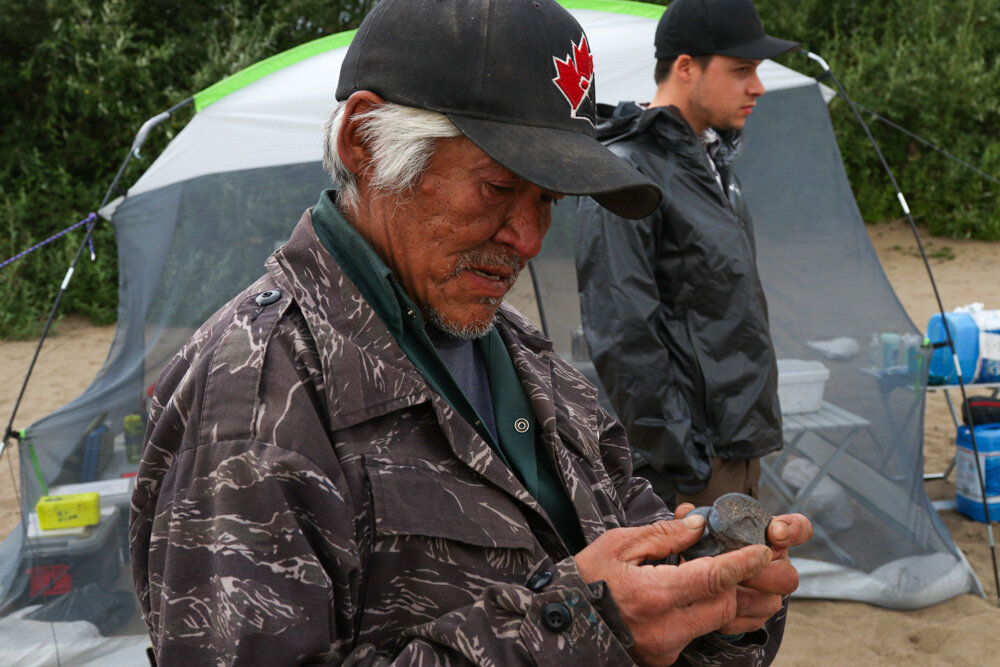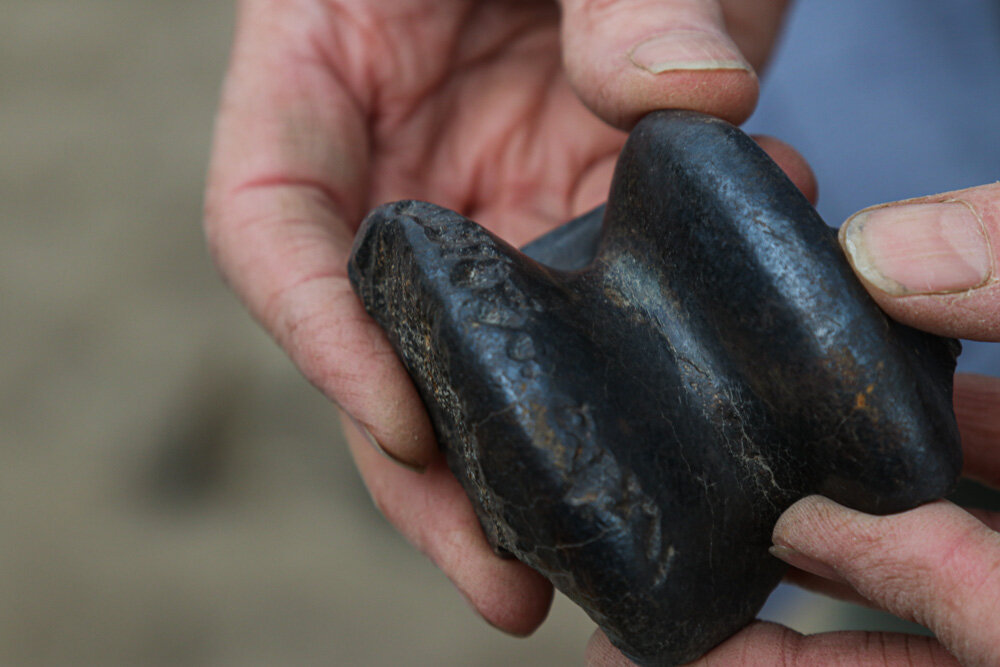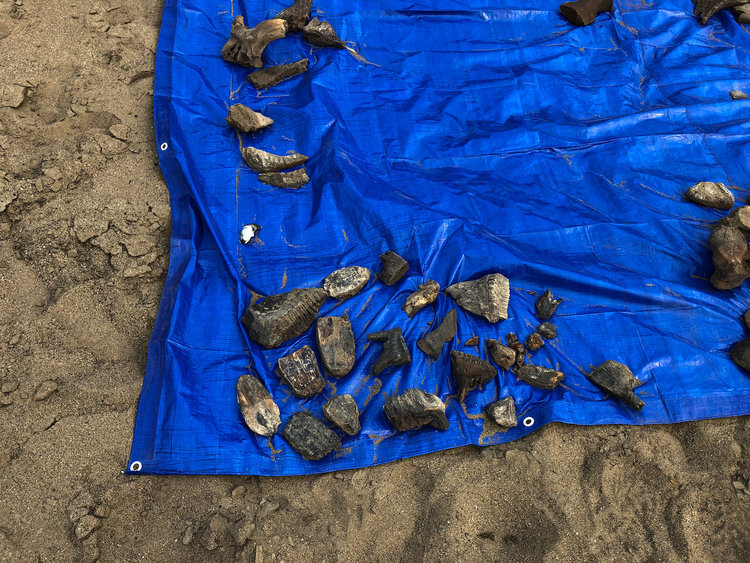A tradition of collaboration moves ice-age science forward
Sarah Williscraft
David Maxwell checks out a fossil found earlier in the day at a site near Old Crow. (Photo: Sarah Williscraft)
A long time ago, there was a giant creature. The giant creature got stuck in a mud pit and was wedged between a lake and a river. It had to use all of its strength to crawl and pull itself out of the mud pit.
When the giant creature finally broke free, the hole it had left was so huge that it caused the lake to drain out into the river. The giant creature trudged upstream and eventually died on the bank of the Whitestone River.
Joe Kyikavichik, a Vuntut Gwitchin elder, shared this piece of his culture’s oral history with a paleontologist named Richard Harington. After hearing this story, Harington and his field assistant decided to investigate.
Days of searching the Whitestone River led to little success. Harington was about to turn back when he remembered an upstream bluff they had not yet examined.
It was there where the core truth of the story told by Kyikavichik was found. Harington discovered the partial remains of an adult female woolly mammoth just where Kyikavichik’s story said it would be. It was the most complete mammoth fossil skeleton ever found near Old Crow.
That was 1967.
Today, I had the opportunity to visit the fly-in community of Old Crow, which remains a hotbed for ice age and Beringian researchers. As the Yukon territory’s northernmost community, the surrounding land is rich with fossilized flora and fauna buried under the sand and riverbeds. Paleontologists from all over the world come to have the chance to learn the histories Old Crow has to offer.
These histories lie in Old Crow’s people just as deeply as they lie in the permafrost. The Vuntut Gwitchin hold knowledge of the land that has been passed down for millennia.
“Everything scientists figure out, we already know before they put all the work into it. But no one asks us,” laughs Brandon Kyikavichik, who works as the heritage interpreter at the John Tizya Centre in Old Crow.
Historically, paleontologists go in, collect their fossils and data, and get out. Up in Old Crow, this is not the case and everyone seems to better from the knowledge and understanding they exchange and gain. The people of this community are a wealth of knowledge regarding their culture and environment. The oral histories, deep understanding of the territory, and the desire to learn and to share that same understanding is what the Vuntut Gwitchin call traditional knowledge. The scientific discoveries made on their land would not be possible without it.
This bone has gnaw marks from an ancient predator. (Photo: Sarah Williscraft)
Richard Harington, the man who found the Whitestone mammoth, also spent part of his career mapping sites of discovery in the Crow Flats. Every time he picked up a fossil or an artifact, he would give the site a name. Modern-day paleontologists still use his mapping system to choose their spots to explore.
It is a warm and windy day in July 2019 when I feel the sand of site CRH 11A between my toes. The site is a 20-minute helicopter ride away from the Old Crow airport. The area is a wide beach on the Crow River, surrounded by trees and tall bushes blowing in the breeze. Fossils -- animal bones and teeth -- that are thousands of years old wash up in the sand from upstream. Several researchers are working away as they sift sediments and identify bones that used to belong to an animal thousands of years ago.
“It’s kind of crazy walking on the bones and then collecting them,” Caleb Charlie tells me. “I’ve heard about this place, but I didn’t realize it was this extraordinary. There are bones just on the edge of the water and you can pick them out.”
Charlie, 21, is a member of the Old Crow community hired to work with the group of paleontologists at 11A. It’s his first time on the very well-known site. Everyone in town has stories or has seen fossils that have been removed from this very beach.
I walk barefoot along the river’s edge and within 15 minutes my arms are full of fossilized teeth and bones. The beach feels like a meeting place for the world of the ice age and all of its wonders to meet the world of today where the sun now beats down on my face.
David Maxwell, 58, is also on the scene to provide his knowledge. He has lived in Old Crow his entire life and has been working with visiting researchers since he was 15 years old.
Caleb Charlie holds a mammoth tusk that was unearthed earlier in the day. (Photo: Sarah Williscraft)
“I’ve worked with botanists, geologists, archeologists, all of the -ologists,” he says with a smile.
Maxwell’s experience and comfort in the field is clear, from his ability to keep giant tents from flying away in the strong winds to cutting down trees and making his own tripod to hold a sifter. However, Maxwell brings so much more than field experience alone.
“Every time you turn a corner, David has another story or connection of how people lived in another time,” says Grant Zazula, one of this trip’s leading paleontologists. “It’s like a continuum of time, and the people and stories he shares are very much alive in the land we work in.”
Zazula and fellow Yukon paleontologist Elizabeth Hall are in Crow Flats to collect ice age fossils, study them, and learn more about what this land was like thousands, and even millions, of years ago.
Some of Zazula’s most recent work includes the discovery of prehistoric hyena teeth found in the Old Crow Basin. The discovery is significant because it may help answer some questions about how hyenas made it over to North America from Eurasia.
“Doing this kind of research on the history of the land can only be done with the people that actually live here,” Zazula tells me, his hands waving as he speaks. “They have deep connections to this place, and it’s a real pleasure to work with them because they have a deep understanding of how the land works. That allows us to make robust interpretations of the past and the history here.”
Elizabeth Hall and David Maxwell work together to identify fossils. (Photo: Grant Zazula)
The Vuntut Gwitchin First Nation’s self-governing agreement, signed in 1993, legally requires researchers to hire community members to take part in their field work. Although it is required of them, researchers very much appreciate having Vuntut Gwitchin people with them.
Margaret Currie and I sit on the beach at site 11A to talk about her experience working with Maxwell and Charlie. She is a paleontologist from Ottawa and is new to the relationship that the Vuntut Gwitchin have built with their visiting researchers.
“We didn’t have an opportunity with Indigenous people on any trips that I can recall. This has been beyond educational for me,” says Currie. “I love having David along in the river or wherever I can ask him so many questions. He knows so much; whatever footprints we find or what kind of birds we see. It’s been really nice.”
Currie says that over her decades-long career, she has worked on sites all over the country but has not consulted Indigenous communities. She says that spending time with Maxwell has enriched her cultural understanding.
The people of Old Crow have been working with visiting researchers like Currie and Zazula for decades. If you ask anyone in town, they will have a connection to this line of work.
“Just about everyone has a story with these people. We all like to do it,” Maxwell tells me. “It means a lot to me for the younger people to learn what kind of bones we find. When little ones grow up, they see those things and know what they are.”
Working with the researchers often leaves a lasting effect on the youth of Old Crow. As he works at 11A, Caleb Charlie tells me of his hopes for this work to open doors to the sciences.
“Maybe I want to pursue a career,” he says
A collection of ancient horse fossils. (Photo: Sarah Williscraft)
A collection of mammoth teeth. (Photo: Sarah Williscraft)
It would not be the first time a young person in Old Crow has built their life around the pursuit of knowledge and preservation of culture. Brandon Kyikavichik, 34, works at the John Tizya Centre and has worked with researchers since he was a young boy.
“Some of the researchers are my real good friends,” says Kyikavichik. “We really enjoy working with them and having them in our community. Some of them even become one of us.”
Kyikavichik is often described as a story keeper by the people in Old Crow for his work in cultural interpretation and revitalization. He processes and catalogues years and years of interviews with elders regarding storytelling, language and knowledge of the land. Kyikavichik also spends time cataloguing fossils found in the Crow Flats. This scientific work supports his study of his own Gwitchin culture.
“The core and foundation of what I do now came from my grandpa and my elders, but without working with those researchers, I would have never ever even thought about collecting and analyzing data,” Kyikavichik says.
Brandon Kyikavichik is the cultural interpreter at the John Tizya Centre in Old Crow. (Photo: Clare Duncan)
The John Tizya Centre of Old Crow is the home of Kyikavichik’s work. The place is crawling with fossils and artifacts catalogued from the Crow Flats. I see a mammoth tusk lying in one corner, an ancient spearhead over there, and when I look on a shelf there is a tooth from a five-foot-tall beaver. Everything is available for curious visitors to touch and feel.
The centre is where Kyikavichik preserves centuries of cultural information the community has documented. He is happy to give visitors tours of the cultural centre to share his knowledge.
Kyikavichik says the scientific discoveries that are made with the help of traditional knowledge are very important to the Vuntut Gwitchin.
“It’s just validation that our oral history shouldn’t be overlooked and that our way of passing down knowledge is effective,” he says. “We weren’t just savages running around in the bush. Everything we did was designed to be the best possible way to live in an Arctic environment.”
The Vuntut Gwitchin have extensive knowledge to share, and Kyikavichik says it is part of their culture to share it. The collaboration of the scientists with the people of Old Crow is one of respect, understanding and learning.
As Kyikavichik walks around the cultural centre, he is surrounded by the history of his ancestors. The John Tizya Centre is a world where people have come together to share cross-cultural information and become better people for the understanding they gain.
Kyikavichik likes to share the story of his great-grandfather Joe Kyikavichik, who led Harington to the Whitestone mammoth decades ago.
The story of the giant creature that got stuck in the mud pit paved the way for a new relationship between people. It continues to allow for discoveries that unearth mysteries from the ice age.
Editor’s note: Interviews and information for this story were gathered during a community stay in Old Crow from July 13-25, 2019.







